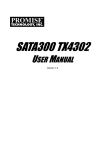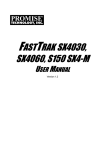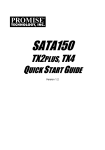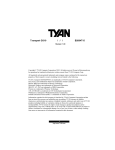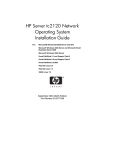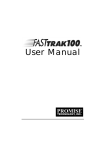Download Promise Technology SATA300 TX4302 User manual
Transcript
SATAII150 AND SATA 300 TX SERIES USER MANUAL Version 1.5 SATAII150 and SATA300 TX Series User Manual Copyright © 2005 Promise Technology, Inc. All Rights Reserved. Copyright by Promise Technology, Inc. (Promise Technology). No part of this manual may be reproduced or transmitted in any form without the expressed, written permission of Promise Technology. Trademarks Promise, and the Promise logo are registered in U.S. Patent and Trademark Office. All other product names mentioned herein may be trademarks or registered trademarks of their respective companies. Important data protection information You should back up all data before installing any drive controller or storage peripheral. Promise Technology is not responsible for any loss of data resulting from the use, disuse or misuse of this or any other Promise Technology product. Notice Although Promise Technology has attempted to ensure the accuracy of the content of this manual, it is possible that this document may contain technical inaccuracies, typographical, or other errors. Promise Technology assumes no liability for any error in this publication, and for damages, whether direct, indirect, incidental, consequential or otherwise, that may result from such error, including, but not limited to loss of data or profits. Promise Technology provides this publication “as is” without warranty of any kind, either express or implied, including, but not limited to implied warranties of merchantability or fitness for a particular purpose. The published information in the manual is subject to change without notice. Promise Technology reserves the right to make changes in the product design, layout, and driver revisions without notification to its users. This version of the User Manual supersedes all previous versions. Recommendations The appearance in this manual of products made by other companies, including, but not limited to software, servers and disk drives, is for the purpose of illustration and explanation only. Promise Technology does not recommend, endorse, prefer or support any product made by another manufacturer. ii Contents Chapter 1: Introduction . . . . . . . . . . . . . . . . . . . . . . . . . . . . . . . . . . . . .1 About This Manual . . . . . . . . . . . . . . . . . . . . . . . . . . . . . . . . . . . . . . .1 Overview . . . . . . . . . . . . . . . . . . . . . . . . . . . . . . . . . . . . . . . . . . . . . .2 SATAII150 and SATA300 TX Series . . . . . . . . . . . . . . . . . . . . . . . . .2 Specifications . . . . . . . . . . . . . . . . . . . . . . . . . . . . . . . . . . . . . . . . . .2 Key Features and Benefits . . . . . . . . . . . . . . . . . . . . . . . . . . . . . . . .3 Chapter 2: Installation . . . . . . . . . . . . . . . . . . . . . . . . . . . . . . . . . . . . . .5 Unpack Your SATAII150 or SATA300 Card . . . . . . . . . . . . . . . . . . .5 Install the SATAII150 or SATA300 Card . . . . . . . . . . . . . . . . . . . . . .6 Install the Disk Drives: SATAII150 TX2plus or SATA300 TX2plus . .7 Install the Disk Drives: SATAII150 TX4 . . . . . . . . . . . . . . . . . . . . . . .9 Install the Disk Drives: SATA300 TX4 . . . . . . . . . . . . . . . . . . . . . . .11 Chapter 3: Install Drivers . . . . . . . . . . . . . . . . . . . . . . . . . . . . . . . . . .13 Make an Installation Floppy Diskette (Windows) . . . . . . . . . . . . . . .14 Windows Server 2003 New Installation . . . . . . . . . . . . . . . . . . . . . . . . . . . . . . . . . . . . .15 Existing Installation . . . . . . . . . . . . . . . . . . . . . . . . . . . . . . . . . .16 Confirm Installation . . . . . . . . . . . . . . . . . . . . . . . . . . . . . . . . . .16 Windows XP New Installation . . . . . . . . . . . . . . . . . . . . . . . . . . . . . . . . . . . . .17 Existing Installation . . . . . . . . . . . . . . . . . . . . . . . . . . . . . . . . . .18 Confirm Installation . . . . . . . . . . . . . . . . . . . . . . . . . . . . . . . . . .18 Windows 2000 New Installation . . . . . . . . . . . . . . . . . . . . . . . . . . . . . . . . . . . . .19 Existing Installation . . . . . . . . . . . . . . . . . . . . . . . . . . . . . . . . . .20 Confirm Installation . . . . . . . . . . . . . . . . . . . . . . . . . . . . . . . . . .20 RedHat Linux New Installation . . . . . . . . . . . . . . . . . . . . . . . . . . . . . . . . . . . . .21 Existing Installation . . . . . . . . . . . . . . . . . . . . . . . . . . . . . . . . . .22 SuSE Linux New Installation 23. . . . . . . . . . . . . . . . . . . . . . . . . . . . . . . . . . . . . Existing Installation 2 . . . . . . . . . . . . . . . . . . . . . . . . . . . . . . . . . .4 Chapter 4: Partition and Format . . . . . . . . . . . . . . . . . . . . . . . . . . . . .25 iii SATAII150 TX2plus, TX4 Series User Manual Chapter 5: Troubleshooting & Tips . . . . . . . . . . . . . . . . . . . . . . . . . .29 Motherboard Issues . . . . . . . . . . . . . . . . . . . . . . . . . . . . . . . . . . . . .29 System CMOS Issues . . . . . . . . . . . . . . . . . . . . . . . . . . . . . . . . . . .30 Drive-Related Issues . . . . . . . . . . . . . . . . . . . . . . . . . . . . . . . . . . . .30 Operating System-Related Issues . . . . . . . . . . . . . . . . . . . . . . . . . .31 Chapter 6: Support . . . . . . . . . . . . . . . . . . . . . . . . . . . . . . . . . . . . . . .33 Frequently Asked Questions . . . . . . . . . . . . . . . . . . . . . . . . . . . . . .33 Contact Technical Support . . . . . . . . . . . . . . . . . . . . . . . . . . . . . . .36 Limited Warranty . . . . . . . . . . . . . . . . . . . . . . . . . . . . . . . . . . . . . . .38 Return Product For Repair . . . . . . . . . . . . . . . . . . . . . . . . . . . . . . .39 iv Chapter 1: Introduction • About This Manual, below • Overview (page 2) • SATAII150 and SATA300 TX Series (page 2) • Specifications (page 2) • Key Features and Benefits (page 3) Thank you for purchasing Promise Technology’s SATAII150 or SATA300 TX Series Controller card. About This Manual This User Manual describes how to setup, use and maintain the • SATAII150 TX2plus and SATAII150 TX4 • SATA300 TX2plus and SATA300 TX4 Serial ATA Controller cards. This manual includes a full table of contents, chapter task lists and crossreferences to help you find the specific information you are looking for. Also included are four levels of notices: Note A Note provides helpful information such as hints or alternative ways of doing a task. Important An Important calls attention to an essential step or point required to complete a task. Important items include things often missed. Caution A Caution informs you of possible equipment damage or loss of data and how to avoid them. Warning A Warning notifies you of probable equipment damage or loss of data, or the possibility of physical injury, and how to avoid them. 1 SATAII150 and SATA300 TX Series User Manual Overview The PC which you are using either already contains a SATAII150 or SATA300 TX Series Controller card installed by a third-party or you have acquired a SATAII150 or SATA300 TX Series Controller card retail product for your existing PC and plan to install the card yourself. • For PC owners wishing to install their SATAII150 or SATA300 TX Series Controller card, go to Chapter 2: Installation on page 5. • For PCs with a SATAII150 or SATA300 TX Series Controller card already installed, and you are experiencing any difficulties with the disk drives being recognized by the card, go to Chapter 6: Troubleshooting on page 51. • If your operating system has crashed for some reason or you have downloaded updated drivers from the Promise website (www.promise.com), you may wish to reinstall software drivers for the SATAII150 or SATA300 TX Series Controller card. See Chapter 3: Installing Drivers on page 33. SATAII150 and SATA300 TX Series Promise originally designed the SATAII150 or SATA300 TX Series as a costeffective, high performance controller cards that add performance and/or reliability to PC desktops and/or servers using Serial ATA drives. SATAII150 and SATA300 TX2plus has two independent data channels to support a maximum of two Serial ATA drives plus a maximum of two Parallel ATA drives. SATAII150 and SATA300 TX4 has four independent data channels to support a maximum of four Serial ATA drives. The SATAII150 or SATA300 TX Series are Controller cards only. They are not capable of creating a Redundant Array of Independent Disks (RAID). For comparable products with RAID capability, consider the Promise FastTrak TX Series Serial ATA RAID Controller cards. Specifications • Low-profile printed circuit board • PCI Slot 33MHz or 66MHz • Controller card dimensions SATAII150 and SATA300 TX2plus (HWD): 2.25 x 4.69 x 0.33 inches (57 x 119 x 8 mm) SATAII150 TX4 (HWD): 2.25 x 6.28 x 0.33 inches (57 x 160 x 8 mm) SATA300 TX4 (HWD): 2.00 x 4.69 x 0.33 inches (57 x 119 x 8 mm) • Operating temperatures: 32° to 122°F (0°C to 50°C) • Operating humidity: 5% to 95% non-condensing 2 Chapter 1: Introduction Key Features and Benefits The following information offers an overview of the major features of your new Promise SATAII150 or SATA300 TX Series. Advanced Hardware Design Features Benefits Supports 66MHz PCI bus motherboards (automatically backward compatible with 33MHz PCI slots) Allows maximum data transfers of up to 266MB per second (133 MB/s in 33 MHz slot) over the bus to dramatically reduce the time to save and retrieve large files. Supports Serial ATA Specification 1.0a Burst data transfer rates up to 150MB/sec from Serial ATA drives to boost overall system performance. Supports Serial ATA Specification II Burst data transfer rates up to 300MB/sec from Serial ATA drives to boost overall system performance. Independent data channels for Serial ATA drives Drives can multiply their data transfer performance when striped together and each drive uses a separate data channel. Master/slave data channel for Conventional master/slave arrangement allows Parallel ATA drives two disk drives on one controller port. PCI Plug-n-Play, PCI Interrupt sharing and coexists with motherboard IDE and SCSI controllers Easy to install; supports up to 4 Serial ATA drives on the SATAII150 and SATA300 TX4 Controller card while still supporting 4 devices on motherboard ATA controller. Employs the latest Promise PCI Serial ATA ASIC technology Fully supports Serial ATA specifications with 150 and 300 MB/sec timing and CRC error-checking at high speeds. DOS based flash upgrade of BIOS and Firmware Verifies proper file, option to backup existing file. Download files from Promise website Configuration Utility for Windows Installed automatically, appears as a taskbar icon, use for controller monitoring, firmware upgrades, drive information and SMART status. 3 SATAII150 and SATA300 TX Series User Manual Compatibility Features Benefits Complies with PCI v2.3 Local Bus standard Provides highest level of hardware compatibility. Complies with SATA Specification 1.0a Provides full compatibility with first generation Serial ATA hard drives. Complies with Serial ATA II: Provides enclosure and drive monitoring Extensions to Serial ATA 1.0a compatibility. Specification Compliant with PCI Bus Master standard. PCI Bus Master support Provides 32-bit I/O and, Bus Master, and Serial ATA performance for optimal system performance. Tested compatibility to coexist Improves system performance and minimizes with motherboards that have system conflicts for new and existing integrated IDE controllers installations. Compatible with all major SATA generation 1 and SATA generation 2, phase 1 and phase 2 disk drives Promise performs verification testing with major drive manufacturers and development partners. Features LBA support Supports drives greater than 137 GB capacity. Supports BIOS Boot Specification All arrays attached to the SATAII150 and SATA300 card appear in the BBS-compliant motherboards BIOS boot list. Compatible with Promise SuperSwap enclosures Provides enclosure management including fan, temperature and voltages. Multiple OSes Supported Windows Server 2003, XP, 2000 RedHat Linux SuSE Linux 4 Chapter 2: Installation • Unpack Your SATAII150 or SATA300 Card, below • Install the SATAII150 or SATA300 Card (page 6) • Install the Disk Drives: SATAII150 TX2plus or SATA300 TX2plus (page 7) • Install the Disk Drives: SATAII150 TX4 (page 9) • Install the Disk Drives: SATA300 TX4 (page 11) This section is designed to quickly get your SATAII150 or SATA300 TX Series Serial ATA Controller card up and running. Unpack Your SATAII150 or SATA300 Card When you receive the SATAII150 or SATA300 TX2plus card, the package should contain the items listed below: • SATAII150 or SATA300 TX2plus Serial ATA Controller card • Quick Start Guide • Two 0.65 m (26 inch) Serial ATA data cables. 1.5 Gb cables for SATAII150, 3.0 Gb cables for SATA300 • One 80-wire 40-pin ATA cable • CD with drivers and SATAII150 and SATA300 TX Series User Manual When you receive the SATAII150 or SATA300 TX4 card, the package should contain the items listed below: • SATAII150 or SATA300 TX4 Serial ATA Controller card • Quick Start Guide • Four 0.65 m (26 inch) Serial ATA data cables. 1.5 Gb cables for SATAII150, 3.0 Gb cables for SATA300 • CD with drivers and SATAII150 and SATA300 TX Series Manual If ANY of the contents are missing or appear to be damaged, please contact your dealer or distributor immediately. Warning Before installing the adapter into an existing system, backup any important or useful data. Failure to follow this accepted PC practice could result in data loss. 5 SATAII150 and SATA300 TX Series User Manual Warning The SATAII150 or SATA300 TX Series Serial ATA Controller cards, like other parts of your system, are subject to damage by static electricity. Be sure that you're properly grounded (Promise recommends that you wear an anti-static strap or touch a grounded object) and that you unplug your system before installing the SATAII150 or SATA300 TX2plus and TX4. Install the SATAII150 or SATA300 Card The SATAII150 or SATA300 TX Series Serial ATA Controller card fits into any available PCI slot on your PC's motherboard (below): • 32-bit PCI slot (must be PCI 2.2 or 2.3 compliant) • The 32-bit portion of a 64-bit PCI or PCI-X slot Attaching screw System frame Bracket SATAII150 or SATA300 Controller card Motherboard PCI slots 1. Remove the cover of your system. 6 Chapter 2: Installation 2. Remove the inside slot cover of an available 32-bit PCI slot on the motherboard.Install the SATAII150 or SATA300 card into the open PCI slot. Secure the bracket to the system's frame. 3. Attach your system case's 2- or 4-pin LED cable to the LED connector on the SATAII150 or SATA300 card (see Install the Disk Drives, below). Make sure that pin 1 on the connector is aligned with pin 1 of the cable. 4. Fasten the controller card bracket to the system case. Note The SATAII150 or SATA300 TX2plus and TX4 Controllers are PCI Plug-n-Play (PnP) devices. No changes are necessary in the Motherboard CMOS Setup for resources or drive types in most applications. Install the Disk Drives: SATAII150 TX2plus or SATA300 TX2plus The SATAII150 or SATA300 TX2plus supports up to two Serial ATA drives and up to two Parallel ATA drives. Caution Use of removable disk drive enclosures other than Promise Technology's SuperSwap is not supported and may result in performance loss or other undesired results. Note If you are using a Promise SuperSwap 1100 or 4100 enclosure in your PC: • Connect the power cables to the SuperSwap enclosure. • Attach a SMBus cable from the Management Connector on the SATAII150 or SATA300 TX2plus card to the Management Connector on the first enclosure These actions are described in Chapter 2 of the SuperSwap User Manual. 1. Install the disk drives into the drive bays of your system. 2. Attach the power cables to the disk drives. 7 SATAII150 and SATA300 TX Series User Manual 3. Attach one Serial ATA data cable to each Serial ATA disk drive. Then attach the other ends of the cables to the connectors on the SATAII150 or SATA300 TX2 plus card (below). Individual LED Connectors Aggregate LED Connectors Parallel Port Port 3 / Channel 3 Port 2 / Channel 2 Port 1 / Channel 1 TX2plus ATAII150 SATAII150 or SATA300 TX2plus Serial ATA Controller card Management Connector 4. Attach a black connector of the Ultra ATA cable to each Parallel ATA hard drive. 5. Verify that the Master and Slave drives each have the appropriate pin settings. Check the drive manufacturer’s documentation for more information. 6. Attach the blue cable connector to the Port 3 Parallel connector on the SATAII150 or SATA300 TX2plus controller card. The colored edge of the cable(s) indicates pin 1. 8 Chapter 2: Installation Install the Disk Drives: SATAII150 TX4 The SATAII150 TX4 supports up to four Serial ATA drives. Caution Use of removable disk drive enclosures other than Promise Technology's SuperSwap is not supported and may result in performance loss or other undesired results. Note If you are using a Promise SuperSwap 1100 or 4100 enclosure in your PC: • Connect the power cables to the SuperSwap enclosure. • Attach a SMBus cable from the Management Connector on the SATAII150 TX4 card to the Management Connector on the first enclosure These actions are described in Chapter 2 of the SuperSwap User Manual. 1. Install the disk drives into the drive bays of your system. 2. Attach the power cables to the disk drives. 9 SATAII150 and SATA300 TX Series User Manual 3. Attach one Serial ATA data cable to each Serial ATA disk drive. Then attach the other ends of the cables to the connectors on the SATAII150 TX4 card (below). Individual LED Connectors Aggregate LED Connectors Port 1 / Channel 1 Management Connector Port 3 / Channel 3 Port 2 / Channel 2 TX4 ATAII150 SATAII150 TX4 Serial ATA Controller card 10 Port 4 / Channel 4 Chapter 2: Installation Install the Disk Drives: SATA300 TX4 The SATA300 TX4 supports up to four Serial ATA drives. Caution Use of removable disk drive enclosures other than Promise Technology's SuperSwap is not supported and may result in performance loss or other undesired results. Note If you are using a Promise SuperSwap 1100 or 4100 enclosure in your PC: • Connect the power cables to the SuperSwap enclosure. • Attach a SMBus cable from the Management Connector on the SATA300 TX4 card to the Management Connector on the first enclosure These actions are described in Chapter 2 of the SuperSwap User Manual. 1. Install the disk drives into the drive bays of your system. 2. Attach the power cables to the disk drives. 11 SATAII150 and SATA300 TX Series User Manual 3. Attach one Serial ATA data cable to each Serial ATA disk drive. Then attach the other ends of the cables to the connectors on the SATA300 TX4 card (below). Port 1 / Channel 1 Individual LED Aggregate LED Connectors Connectors Port 2 / Channel 2 Management Connector Port 3 / Channel 3 Port 4 / Channel 4 TX4 ATA 300 SATA300 TX4 Serial ATA Controller card 12 Chapter 3: Install Drivers • Make a Driver Installation Diskette (Windows), page 14 • Windows Server 2003 • • • • • New, page 15 • Exsting, page 16 • Confirm, page 16 Windows XP • New, page 17 • Exsting, page 18 • Confirm, page 18 Windows 2000 • New, page 19 • Exsting, page 20 • Confirm, page 20 RedHat Linux • New, page 21 • Exsting, page 22 SuSE Linux • New, page 23 • Exsting, page 24 Following are driver installation procedures for the Windows operating systems that support the SATAII150 and SATA300 TX Series Serial ATA Controller cards. The drivers for Windows are included on the CD. Drivers and installation instructions for Linux operating systems are downloadable from the Promise website at www.promise.com. 13 SATAII150 and SATA300 TX Series User Manual Make an Installation Floppy Diskette (Windows) This procedure requires one write-enabled blank 3.5-inch diskette. 1. Place your blank diskette in the appropriate drive. 2. Insert the Promise CD into your CD-ROM drive. The display screen should open automatically. If the display screen does not open, click on MyComputer > CD Drive D: and double-click on the Launch.exe icon. 3. Click on the Windows Driver button. The Disk Copy Utility opens. 4. Click the Create button in the Utility. A confirmation box appears. 5. Click the Yes button in the confirmation box. The utility prepares your driver installation diskette. When the utility is finished, it displays a message. 6. In the message, click the OK button. 7. Click the Exit button to close the Promise CD. 14 Chapter 3: Install Drivers Windows Server 2003 New Installation The following details the installation of the SATAII150 or SATA300 Serial ATA Controller drivers while installing Windows Server 2003. 1. Start the installation: • Floppy Install: Boot the computer with the Windows Server 2003 installation diskettes. • CD-ROM Install: Boot from the CD-ROM. Press F6 after the message “Press F6 if you need to install third party SCSI or RAID driver” appears. 2. When the Windows Server 2003 Setup window is generated, press S to specify an Additional Device(s). 3. Insert the driver diskette into drive A: and press Enter. 4. Choose Windows Promise SATAII150/SATA300TX2plus [or TX4] (tm) IDE Controller from the list that appears on screen, and then press the Enter. 5. Press S to use the driver on the floppy disk and then press Enter to continue with installation. 6. The Windows Server 2003 Setup screen will appear again saying “Setup will load support for the following mass storage devices:” The list will include “Windows Promise SATAII150/SATA300TX2plus [or TX4] (tm) IDE Controller”. NOTE: If there are any additional devices to be installed, specify them now. When all devices are specified, continue to the next step. 7. From the Windows Server 2003 Setup screen, press the Enter. Setup will now load all device files and then continue the Windows Server 2003 installation. 15 SATAII150 and SATA300 TX Series User Manual Existing Installation After installing the STAII150 or SATA300 Serial ATA Controller card and rebooting your system, Windows Server 2003 setup will show a “Found New Hardware” dialog box. Under Windows 2003, “Mass Storage Controller” will be displayed. 1. Insert the driver diskette into the A:\ drive. 2. Choose Install the software automatically and press the Enter key. 3. Choose Windows Promise SATAII150/SATA300TX2plus [or TX4] (tm) IDE Controller from the list that appears on screen, and then press the Enter key. 4. If using a driver that has not been digitally signed by Microsoft, you will be asked if you want to continue the installation. Click Continue anyway. 5. When the New Hardware Wizard has finished installing the SATAII150 or SATA300 driver, click Finish. Confirm Installation 1. Right-click on the My Computer icon and select Manage from the popup menu. 2. From the left panel, select Device Manager. 3. Click the “+” in front of SCSI and RAID controllers. “Windows Promise SATAII150/SATA300TX2plus [or TX4] (tm) IDE Controller” should appear. 16 Chapter 3: Install Drivers Windows XP New Installation The following details the installation of the SATAII150 or SATA300 Serial ATA Controller drivers while installing Windows XP. 1. Start the installation: • Floppy Install: Boot the computer with the Windows XP installation diskettes. • CD-ROM Install: Boot from the CD-ROM. Press F6 after the message “Press F6 if you need to install third party SCSI or RAID driver” appears. 2. When the Windows XP Setup window is generated, press S to specify an Additional Device(s). 3. Insert the driver diskette into drive A: and press Enter. 4. Choose Windows Promise SATAII150/SATA300TX2plus [or TX4] (tm) IDE Controller from the list that appears on screen, and then press the Enter. 5. Press S to use the driver on the floppy disk and then press Enter to continue with installation. 6. The Windows XP Setup screen will appear again saying “Setup will load support for the following mass storage devices:” The list will include “Windows Promise SATAII150/SATA300TX2plus [or TX4] (tm) IDE Controller”. NOTE: If there are any additional devices to be installed, specify them now. When all devices are specified, continue to the next step. 7. From the Windows XP Setup screen, press the Enter. Setup will now load all device files and then continue the Windows XP installation. 17 SATAII150 and SATA300 TX Series User Manual Existing Installation After installing the SATAII150 or SATA300 Serial ATA Controller card and rebooting your system, Windows XP setup will show a “Found New Hardware” dialog box. 1. Insert the driver diskette into the A:\ drive. 2. Choose Install the software automatically and press the Enter key. 3. Choose Windows Promise SATAII150/SATA300TX2plus [or TX4] (tm) IDE Controller from the list that appears on screen, and then press the Enter key. 4. If using a driver that has not been digitally signed by Microsoft, you will be asked if you want to continue the installation. Click Continue anyway. 5. When the New Hardware Wizard has finished installing the SATAII150 or SATA300 driver, click Finish. Confirm Installation 1. Right-click on the My Computer icon and select Manage from the popup menu. 2. From the left panel, select Device Manager. 3. Click the “+” in front of SCSI and RAID controllers. “Windows Promise SATAII150/SATA300TX2plus [or TX4] (tm) IDE Controller” should appear. 18 Chapter 3: Install Drivers Windows 2000 New Installation The following details the installation of the SATAII150 or SATA300 Serial ATA Controller drivers while installing Windows 2000. 1. Start the installation: • Floppy Install: Boot the computer with the Windows 2000 installation diskettes. • CD-ROM Install: Boot from the CD-ROM. Press F6 after the message “Press F6 if you need to install third party SCSI or RAID driver” appears. 2. When the Windows 2000 Setup window is generated, press S to specify an Additional Device(s). 3. Insert the driver diskette into drive A: and press Enter. 4. Choose Windows Promise SATAII150/SATA300TX2plus [or TX4] (tm) IDE Controller from the list that appears on screen then press Enter. 5. The Windows 2000 Setup screen will appear again saying “Setup will load support for the following mass storage devices:” The list will include “Windows Promise SATAII150/SATA300TX2plus [or TX4] (tm) IDE Controller”. NOTE: If there are any additional devices to be installed, specify them now. When all devices are specified, continue to the next step. 6. From the Windows 2000 Setup screen, press Enter. Setup will now load all device files and then continue the Windows 2000 installation. 19 SATAII150 and SATA300 TX Series User Manual Existing Installation After installing the SATAII150 or SATA300 Serial ATA Controller card and rebooting your system, Windows 2000 setup will show a “New Hardware Found” dialog box. Under Windows 2000, “PCI Mass Storage Controller” will be displayed. 1. Choose Add New Hardware Wizard from the list, and then press Enter. 2. Choose Add/Troubleshoot a device and click Next. The new hardware wizard will show device list. 3. The screen show a “Welcome to the Found New Hardware Wizard” dialog box. Click Next. 4. Choose Display a list the known drivers for this device so that I can choose a specific driver, then click Next. 5. Select SCSI and RAID controllers, then click Next. 6. When the Windows 2000 supported SCSI adapter drivers list appears, click Have disk. 7. Insert the driver diskette in drive A:\ 8. Type A:\ in the text box, then click OK 9. Choose Windows Promise SATAII150/SATA300TX2plus [or TX4]( tm ) IDE controller from the list that appears on screen, then click Next. 10. If using a driver that has not been digitally signed by Microsoft, you will be asked if you want to continue the installation. Click Yes. 11. Click Yes to confirm continue the installation and copy the driver to system. 12. Remove the diskete and click Finish to restart the system. Windows 2000 will then restart for the driver installation to take effect. Confirm Installation 1. Right-click on the My Computer icon and select Manage from the popup menu. 2. From the left panel, select Device Manager. 3. Click the “+” in front of SCSI controllers. “Windows Promise SATAII150/ SATA300TX2plus [or TX4] (tm) IDE Controller” should appear. 20 Chapter 3: Install Drivers RedHat Linux Prepare a driver diskette: 1. Download the RedHat Linux driver from the Promise website at www.promise.com 2. Extract the contents of the ZIP file on to a formatted floppy disk. Use WinZIP in Windows or unzip in Linux. 3. Label the disk “SATAII 150 Driver Disk”. New Installation 1. Boot the Linux system from the Red Hat Linux Installation with CD. At the “Welcome to Red Hat linux ...” installation screen, a prompt labeled “boot:” will appear at the bottom of the screen. 2. At the boot prompt, type expert and press the Enter key. 3. At the Devices dialog box, insert the SATAII 150 Driver Disk in the floppy drive and then select OK or Yes. See the Note below. 4. Continue with the installation as normal. 5. When installation is at the Congratulations menu, press Ctrl-Alt-F2 to switch screens. 6. Insert the SATAII 150 Driver Disk into the floppy drive. 7. Type the following commands to load SATAII 150 driver: # umount /tmp/fd0 (if this command fails, ignore it and go to the next one) # chroot /mnt/sysimage # mount /dev/fd0 /mnt # cd /mnt # sh setup-ut # cd / # umount /mnt # exit 8. Please Press Ctrl-Alt-F7 and click the Exit button to finish the installation. NOTE: Red Hat Linux will not provide onboard IDE as standard ide0 and ide1 on some mother boards. To solve this condition, append the boot parameters as follows. ide0=0x1f0,0x3f6,14 ide1=0x170,0x376,15 ide2=0 ide3=0 ide4=0 ide5=0 ide6=0 ide7=0 ide8=0 ide9=0 21 SATAII150 and SATA300 TX Series User Manual Existing Installation 1. Boot the Linux system and log in as root. 2. Insert SATAII 150 Driver Disk 3. In a terminal window, enter the following commands: # mount /dev/fd0 /mnt/floppy # cd /mnt/floppy # sh install Note: At the prompt answer Yes to load SATAII 150 driver every time Linux boots. # cd .. # umount /dev/fd0 22 Chapter 3: Install Drivers SuSE Linux Prepare a driver diskette: 1. Download the RedHat Linux driver from the Promise website at www.promise.com 2. Extract the contents of the ZIP file on to a formatted floppy disk. Use WinZIP in Windows or unzip in Linux. 3. Label the disk “SATAII 150 Driver Disk”. New Installation 1. Boot the Linux system from the SuSE Linux Installation with CD. 2. When system boots, press F3 for Driver Disk and select the Installation option. See the Note below. 3. When “Please insert the Driver Update floppy” displays, insert the SATAII 150 Driver Disk into the floppy drive. 4. When Driver Update Menu appears, select OK then select “back” to return to the installer. 5. Continue with the installation as normal. 6. If you are using SMP system, add a parameter “acpi=off” to “kernel boot parameters” in the Booting menu of Installation Settings. NOTE: There is a SMP issue on the SuSE Linux SMP kernel. If you encounter problems on SuSE with SMP system, append “acpi=off” parameters into boot loader or select “Installation – ACPI Disabled” on SuSE Linux SMP. 23 SATAII150 and SATA300 TX Series User Manual Existing Installation 1. Boot the Linux system and log in as root. 2. Insert SATAII 150 Driver Disk 3. In a terminal window, enter the following commands: # mount /dev/fd0 /floppy # cd /floppy # sh install Note: At the prompt answer Yes to load SATAII 150 driver every time Linux boots. # cd / # umount /floppy 24 Chapter 4: Partition and Format In order for your operating system to recognize and work with the disk drives attached to your SATAII150 or SATA300 TX Series Controller card, the drives must be partitioned and formatted. • If your drives were previously partitioned and formatted they are ready to use and you can skip this chapter • If your drives have not been partitioned and formatted, you must do that job before you can use them The actions of partitioning and formatting create a file structure on the disk drives with which your operating system can work. In the example below, we show how this is done in Windows. A similar procedure is required for Linux PC’s. However, partitioning and formatting in Linux is unautomated, therefore please refer to your system documentation for the exact procedure. Note If you plan to boot your computer from this array, go to Windows and Device Driver Installation under the Installation section for instructions. The instructions here are for data arrays only. 1. From the desktop, right-click on the My Computer icon and select Manage from the popup menu. The Computer Management window opens. 2. From the left menu, click on Disk Management. The Disk Management window opens with your new array identified as Disk 1. The Initialize Wizard appears automatically. 25 SATAII150 and SATA300 TX Series User Manual 3. Click the Next button to start the Wizard. 4. In the following windows, select Disk 1 to Initialize. Do not select any disks to Convert. Click the Finish button to Initialize the array. 5. Right-click on the Unallocated portion of Disk 1 and select New Partition... from the popup menu. The New Partition Wizard appears. 26 Chapter 4: Partition and Format 6. Click the Next button to start the wizard. 7. In the following windows, do the following actions. Click Next to move to the next window. 8. • Select Primary Partition • Specify the maximum available partition size in MB • Assign the available drive letter of your choice • Choose Format this partition with the following settings • File system: NTFS • Allocation unit size: Default • Volume label: Enter your choice of name • Do not check “Perform a quick format” or “Enable file and folder compression” Review your selections and click Finish. The New Partition Wizard will disappear while partitioning and formatting begin. This process will take some time. The Disk Management window displays the progress. 27 SATAII150 and SATA300 TX Series User Manual When formatting is complete, your array will appear as a hard drive in the Disk Management window (above) and the My Computer window (below). 28 Chapter 5: Troubleshooting & Tips • Motherboard Issues, below • System CMOS Issues, page 30 • Drive-Related Issues, page 30 • Operating System-Related Issues, page 31 This section is used to assist with troubleshooting conflicts and SATAII150 or SATA300 Series Controller card installation problems. Also refer to the README.TXT file on the CD for more recent information as well as the PromiseOnline services listed on page 36. The section is divided into the following categories: Motherboard Issues, System CMOS Issues, Drive Errors, Operating System Errors, and Audio/Video Editing Tips. Motherboard Issues Freeing additional IRQ resources Since the Promise card supports PCI Interrupt sharing, it is possible to use IRQs already assigned to another PCI card. Interrupt Sharing is not supported with onboard IDE controllers. If the onboard IDE controller(s) are not used, you may disable the controllers to free IRQ 14 and/or 15. Configuring PCI IRQ resources Setting the IRQ for a particular PCI slot will be different depending on the motherboard BIOS. This setting is usually made in the PCI Configuration and/or Plug and Play (PnP) section of the motherboard BIOS setup. There are three common methods that motherboard BIOS's handle assignment of IRQs to PCI slots: • Specifically assigning an IRQ to a particular slot - You can tell the motherboard to use IRQ 10 for PCI slot 1, IRQ 11 for PCI slot 2, etc. • Listing which IRQs are available to be assigned to the PCI slots – This BIOS has an option where you specify 1st Available IRQ, 2nd Available IRQ, etc. The BIOS then scans the PCI slots for PCI cards and assigns these IRQs in the order that it finds the PCI cards. Consult your motherboard manual for information that is specific to your motherboard. 29 SATAII150 and SATA300 TX Series User Manual Intermittent data problems Overclocking the PCI bus may cause the system to hang or data corruption. If you experience either of these problems and you are overclocking the PCI bus, set the PCI bus back to its normal setting to see if this is causing the errors. System CMOS Issues Set Motherboard CMOS Boot sequence to boot to SATAII150 or SATA300 Serial ATA Controller On some Motherboard BIOS, it is necessary to set the Boot sequence to SCSI, A:, C: since the Promise card is identified as a SCSI card. Motherboard CMOS displays C: or D: drive failure during startup See the Drive-Related Errors section. Using an Onboard IDE Card with SATAII150 or SATA300 Serial ATA Controller If an onboard IDE controller is installed with hard disks, enable support in the Motherboard Standard CMOS Setup for the drives. Note that the onboard IDE hard drives will then be the bootable hard disk unless the system BIOS has a boot sequence setting with the option to specify booting to a different device. Drive-Related Issues Drives cannot be formed into an array The SATAII150 and SATA300 Controllers support Serial ATA disk drives but they do not support RAID. Therefore you cannot build a RAID array with this product. System CMOS displays C: or D: drive failure during Startup Do not reference C: or D: in the Motherboard Standard CMOS for drives attached to the SATAII150 or SATA300 TX Series Serial ATA Controller. Only enter drive information in the Motherboard CMOS for drives attached to the onboard IDE controller. 30 Chapter 5: Troubleshooting and Tips Operating System-Related Issues Promise Windows driver does not appear in Device Manager Windows may already be listing the controller under Other Devices instead of the Hard disk controllers section. In Device Manager under Other Devices to see if it lists a PCI Card or RAID Controller. If so, highlight this listing and click on the Properties button then click on the Driver tab. Depending on your version of Windows, choose either Change Driver or Update Driver. Follow the on-screen prompts to complete installation of the driver. If Windows asks if you want to test if the device can be removed safely, click on CANCEL. Reboot the system to complete installation of the driver. "Inaccessible Boot Device" Message Appears During Floppyless Install of Windows NT, , 2000, or XP or Server 2003 The F6 key was not pressed at the appropriate time. Reboot the system, and press the F6 key when the message "Press F6 if you need to install third party SCSI or RAID driver" appears in Windows 2000, XP or Server 2003. "No Hard Drives Found" Message Appears During CD-ROM Install of Windows NT, 2000, or XP or Server 2003 The F6 key was not pressed at the appropriate time. Reboot the system, and press the F6 key when the message "Press F6 if you need to install third party SCSI or RAID driver" appears in Windows 2000, and XP or Server 2003. 31 SATAII150 and SATA300 TX Series User Manual 32 Chapter 6: Support • Frequently Asked Questions, below • Contact Technical Support, page 36 • Limited Warranty, page 38 • Return Product for Repair, page 39 Frequently Asked Questions This section lists frequently asked questions involving pre-installation, drive issues, installation, and post-installation. Pre-Installation (Speed, Device Types, Capacity, Cabling) What kind of hard drives can I use with the SATAII150 or SATA300 Controller card? You can use any Serial ATA disk drive(s) to create arrays on the SATAII150 or SATA300 Serial ATA Controller card. Use matching drives for multipledrive arrays to maximize capacity usage as well as performance. Will ACPI work with disk drives on the SATAII150 or SATA300 Controller card? Yes. Can I use ATAPI devices on the SATAII150 or SATA300 Controller card? Yes. The SATAII150 and SATA300 Serial ATA Controller cards support Serial ATAPI devices. Will the SATAII150 or SATA300 Controller card work with 66MHz PCI bus speed? Yes, the SATAII150 and SATA300 Serial ATA Controller cards are designed to accommodate the newer PCI bus speed and is backward compatible with 33MHz speeds. How can I change the resources that the SATAII150 or SATA300 uses? The SATAII150 and SATA300 Serial ATA Controller cards are fully PnP. This means all the resources that it uses are given to it by the PnP BIOS on the motherboard. The SATAII150 andSATA300 Controllers support IRQ sharing, but this will not work unless ALL the concerned devices support the feature. If your motherboard allows you to control the assignment of these resources, you may be able to remedy the problem by: 33 SATAII150 and SATA300 TX Series User Manual • Changing the IRQ assignments to the PCI slots in the motherboard BIOS during boot up. • Reset the configuration data in your CMOS. This is usually an option in the PnP section of your CMOS. • Otherwise, switch the SATAII150 or SATA300 card to a different PCI slot. Drive Issues Do the disk drives on the SATAII150 or SATA300 Controller have to be the same size? The disk drives connected to the SATAII150 or SATA300 Serial ATA Controller card do not have to be the same size, make or model. I already have an older Promise controller. Can I move the disk drives to my new SATAII150 or SATA300 controller? Yes, provided your drives are Serial ATA disk drives. If I have a problem with one of the drives on the SATAII150 or SATA300 Controller, how can I low-level format it to correct the problem? Do NOT do this. Low-level formatting is unnecessary and generally does not correct problems commonly experienced. If you think the disk drive is faulty, run the drive manufacturer’s diagnostic utility on it. Errors such as bad sectors or ECC/CRC failure are best remedied by completely replacing the drive. For this reason, do NOT low-level format the drives attached to the SATAII150 or SATA300 controller. Do I have to install disk management software on my array in order to access the full storage capacity of drives? No! Disk management software will only complicate things. Your disk drives should be fully addressable by your OS as they are. Consult your OS documentation about partitioning larger drives. What system BIOS setup settings do I use for the drives on the SATAII150 or SATA300 Serial ATA Controller card? None. The drives on the SATAII150 and SATA300 Controllers are supported by the Promise BIOS and/or OS drivers, not by your system BIOS. 34 Chapter 6: Support Installation Issues (Capacity, Booting) How can I change the system boot sequence in order to boot from drives on the SATAII150 or SATA300 Controller? The boot sequence is controlled by the system BIOS. As far as the system BIOS is concerned, the SATAII150 or SATA300 Serial ATA Controller and its defined arrays are categorized as a SCSI device. This allows you to set the boot sequence in your BIOS setup utility to boot from SCSI first, rather than IDE. If there are multiple SCSI add-in controllers in the system, then the boot sequence among is determined by their PCI slot priority. PCI slot #1 will be first, slot #2 second, etc. If you want to boot from the array, put the SATAII150 or SATA300 Controller in the PCI slot where it will be accessed before the other SCSI controllers. How can I change the boot sequence between a PCI SCSI card and the SATAII150 or SATA300 Controller? Since all PCI devices are PnP, it is difficult to determine which device is addressed first. Some newer motherboard BIOSes have advanced options that identify devices and allow you to select which device will be assigned resources first. Otherwise you may have to physically switch the device cards on the PCI slots so that the boot device is in the highest priority slot number, as described in the previous answer. 35 SATAII150 and SATA300 TX Series User Manual Contact Technical Support Promise Technical Support provides several support options for Promise users to access information and updates. We encourage you to use one of our electronic services, which provide product information updates for the most efficient service and support. If you decide to contact us, please have the following information available: • Product model and serial number • BIOS and driver version numbers • A description of the problem / situation • System configuration information, including: motherboard and CPU type, hard drive model(s), ATA/ATAPI drives & devices, and other controllers. Technical Support Services Promise Online™ Web Site http://www.promise.com (technical documents, drivers, utilities, etc.) North and South America E-mail Support [email protected] Fax Technical Support (408) 228-1097 Attention: Technical Support Phone Technical Support (408) 228-1400 option 4 7:30-5:30pm M-F Pacific Standard Time If you wish to write us for support: Promise Technology, Inc. Attn: Technical Support 580 Cottonwood Drive Milpitas, CA 95035, USA 36 Chapter 6: Support Europe, Africa and Middle East E-mail Support [email protected] Fax Technical Support +31 (0) 40 256 9463 Attention: Technical Support Phone Technical Support +31 (0) 40 235 2600 8:30-5:00pm The Netherlands Time If you wish to write us for support: Promise Technology Europe B.V. Attn: Technical Support Luchthavenweg 81-125 5657 EA Eindhoven, The Netherlands Pacific Rim E-mail Support [email protected] Fax Technical Support +886 3 564 53 13 Attention: Technical Support Phone Technical Support +886 3 578 23 95 (ext. 8873) 9:00-5:30pm Taiwan Time If you wish to write us for support: Promise Technology, Inc. Attn: Technical Support 2F, No. 30, Industry E. Rd. IX Science-based Industrial Park Hsinchu, Taiwan, R.O.C. China E-mail Support [email protected] Fax Technical Support +86 10 8857-8015 Attention: Technical Support Phone Technical Support +86 10 8857-8085 / -8095 9:00-6:00pm China Time If you wish to write us for support: Promise Technology China Attn: Technical Support Room 1205, Tower 3, Webok Time Center N. 17 South Zhong Guan Cun Street Hai Dian District, Beijing 100081 P.R. China 37 SATAII150 and SATA300 TX Series User Manual Limited Warranty Promise Technology, Inc. (“Promise”) warrants that for three (3) years from the time of the delivery of the product to the original end user: a) the product will conform to Promise’s specifications; b) the product will be free from defects in material and workmanship under normal use and service. This warranty: a) applies only to products which are new and in cartons on the date of purchase; b) is not transferable; c) is valid only when accompanied by a copy of the original purchase invoice. d) Is not valid on spare parts, fans, and power supplies This warranty shall not apply to defects resulting from: a) improper or inadequate maintenance, or unauthorized modification(s), performed by the end user; b) operation outside the environmental specifications for the product; c) accident, misuse, negligence, misapplication, abuse, natural or personal disaster, or maintenance by anyone other than a Promise or a Promise-authorized service center. Disclaimer of other warranties This warranty covers only parts and labor, and excludes coverage on software items as expressly set above. Except as expressly set forth above, Promise DISCLAIMS any warranties, expressed or implied, by statute or otherwise, regarding the product, including, without limitation, any warranties for fitness for any purpose, quality, merchantability, non-infringement, or otherwise. Promise makes no warranty or representation concerning the suitability of any product for use with any other item. You assume full responsibility for selecting products and for ensuring that the products selected are compatible and appropriate for use with other goods with which they will be used. Promise DOES NOT WARRANT that any product is free from errors or that it will interface without problems with your computer system. It is your responsibility to back up or otherwise save important data before installing any product and continue to back up your important data regularly. 38 Chapter 6: Support No other document, statement or representation may be relied on to vary the terms of this limited warranty. Promise’s sole responsibility with respect to any product is to do one of the following: a) replace the product with a conforming unit of the same or superior product; b) repair the product. Promise shall not be liable for the cost of procuring substitute goods, services, lost profits, unrealized savings, equipment damage, costs of recovering, reprogramming, or reproducing of programs or data stored in or used with the products, or for any other general, special, consequential, indirect, incidental, or punitive damages, whether in contract, tort, or otherwise, notwithstanding the failure of the essential purpose of the foregoing remedy and regardless of whether Promise has been advised of the possibility of such damages. Promise is not an insurer. If you desire insurance against such damage, you must obtain insurance from another party. Some states do not allow the exclusion or limitation of incidental or consequential damages for consumer products, so the above limitation may not apply to you. This warranty gives specific legal rights, and you may also have other rights that vary from state to state. This limited warranty is governed by the State of California. Your Responsibilities You are responsible for determining whether the product is appropriate for your use and will interface with your equipment without malfunction or damage. You are also responsible for backing up your data before installing any product and for regularly backing up your data after installing the product. Promise is not liable for any damage to equipment or data loss resulting from the use of any product. Return Product For Repair If you suspect a product is not working properly, or if you have any questions about your product, contact our Technical Support Staff through one of our Technical Services, making sure to provide the following information: • Product model and serial number (required) • Return shipping address • Daytime phone number • Description of the problem • Copy of the original purchase invoice 39 SATAII150 and SATA300 TX Series User Manual The technician will assist you in determining whether the product requires repair. If the product needs repair, the Technical Support Department will issue an RMA (Return Merchandise Authorization) number. Return ONLY the specific product covered by the warranty (do not ship cables, manuals, diskettes, etc.), with a copy of your proof of purchase to: USA and Canada: Promise Technology, Inc. Customer Service Dept. Attn.: RMA # ______ 1745 McCandless Drive Milpitas, CA 95035 Other Countries: Return the product to your dealer or retailer. Contact them for instructions before shipping the product. You must follow the packaging guidelines for returning products: • Use the original shipping carton and packaging • Include a summary of the product’s problem(s) • Write an attention line on the box with the RMA number • Include a copy of proof of purchase You are responsible for the cost of insurance and shipment of the product to Promise. Note that damage incurred due to improper transport or packaging is not covered under the Limited Warranty. When repairing returned product(s), Promise may replace defective parts with new or reconditioned parts, or replace the entire unit with a new or reconditioned unit. In the event of a replacement, the replacement unit will be under warranty for the remainder of the original warranty term from purchase date, or 30 days, whichever is longer. Promise will pay for standard return shipping charges only. You will be required to pay for any additional shipping options (such as express shipping). 40















































